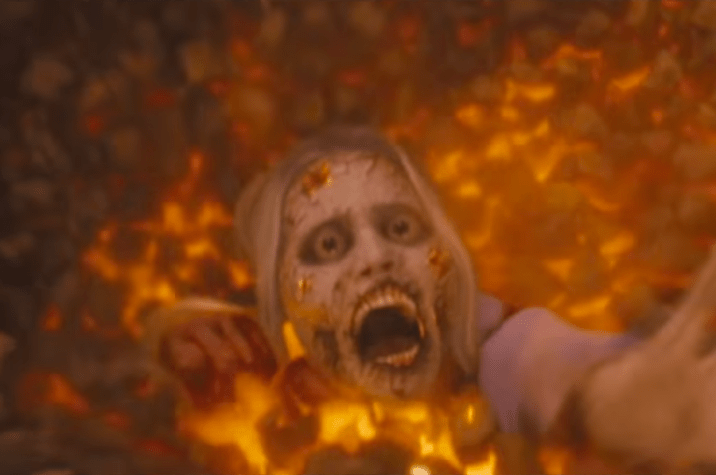Scene Screams is a recurring column that spotlights the scenes in horror that make us scream, whether through fear, laughter, or tears. It examines the most memorable, and often scariest, scenes in horror and what it is about them that makes them get under our skin.
Comedy and horror make excellent bedfellows because of their similarities. Both aim to elicit an extreme, specific response from audiences, and both go about it through a build-up and release. Horror movies create tension then release it through scares, but the build-up and release of terror are sometimes most important in the movie’s punchline- its conclusion. A film’s ending is, after all, the last thing the viewer soaks in before the end credits roll and the experience is over. All of which to say that Sam Raimi’s Drag Me to Hell effectively nailed its morally grey ending, and it hits just as hard today as it did upon release.
Loan officer Christine Brown (Alison Lohman) wants a promotion, but her mild-mannered temperament means she’s outperformed by her more assertive and conniving coworker, Stu Rubin (Reggie Lee). Christine denies the third mortgage extension for the elderly Sylvia Ganush (Lorna Raver) despite pleas and begging to prove she has what it takes to land the coveted position. When Christine leaves work for the day, Sylvia corners her in the parking garage, assaults her, then curses her after snatching a button from her coat. That curse dooms Christine to three days of increasing supernatural torture by a Lamia and will end when she’s dragged to Hell.

Despite the film’s title, the viewer spends the movie with Christine waiting for her to finally discover how to break the curse and avoid a nasty fate. As the hauntings begin to plague Christine, she wastes little time trying to break her curse. She attempts to apologize to Sylvia, only to find the woman dead. Christine seeks out help from a fortune teller Rham Jas (Dileep Rao), for answers. Through his advice and her desperation, Christine winds up offering her kitten as a sacrifice to the Lamia, attending a séance that claims the life of medium San Dena (Adriana Barraza), and the final attempt to give her curse away by handing off that button to a new victim. She ponders giving it to the vile Stu but instead digs up Sylvia’s grave to give back the cursed button.
Dawn brings a sunnier disposition for Christine. She receives news that she got the promotion after Stu was fired, and she’s about to embark on a romantic trip with boyfriend Clay (Justin Long) that will end in a marriage proposal. It’s the precise type of happy ending audiences have been conditioned to expect; Christine may have made some egregiously selfish missteps along the way, but she is the heroine in this story.

Then Clay pulls out the envelope containing the cursed button, and Christine recoils in dawning fear. She falls backward onto the train tracks as a train rolls toward the station. It’s then that the protagonist gets ruthlessly dragged into Hell while Clay looks on in abject horror. Cut to the title card to drive home that Raimi made good on the film’s name.
It’s the precise type of shocking ending that fans still debate about over a decade later; did Christine deserve her fate? Raimi intentionally spends much of Christine’s story presenting a character prone to making poor decisions out of self-preservation, pre and post curse. But her flaws balance out with more likable traits and choices, too. She’s humanized more through her relationship with Clay, the option to ultimately not doom Stu even when he’s reprehensible, and she fesses up to the pain she inflicted upon Sylvia. Christine deserves punishment for the kitten and dooming Sylvia’s home, but perhaps not to the extent of a Lamia dragging her to Hell to feast on her soul.

But that’s debatable, which contributes to the ending’s enduring quality. The other factors that make this so potent are misdirection and abruptness. The horrifying imagery of Christine screaming for help as a train steamrolls on above her, hands pulling her down into the fiery pits as her flesh melts off sticks with you. It’s made even more effective because it comes as a sudden tonal shift to the cheery, happily ever after vibe that came just moments before.
Christine’s final encounter with Sylvia’s corpse gave a sense of climactic finality, and the following scene marked the start of a new chapter for Christine. It gave viewers a sense of closure; the protagonist defeated her antagonist and came away from her confrontation full of hope and honesty. It makes the timing of her doom downright cruel.
Horror frequently paints a clear picture between good and evil, yet Drag Me to Hell blurs the lines. Even still, that final rug pull evokes such an unexpected, visceral response. It’s as much to do with Christine as a flawed protagonist as it is in the way Raimi structures this story. Raimi is a master of horror-comedy and knows how to deliver a dramatic horror punchline that sticks with you years later.

